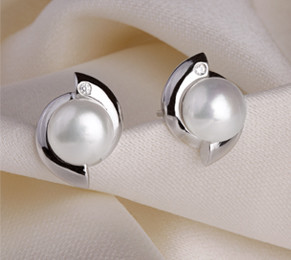If we want to talk about pearls, I hope you have set aside enough time because there is truly a lot to say. Pearls are addictive; their history and reality hardly change, and the future predicts even greater popularity of these jewelry pieces, mainly made of freshwater pearls. They are a symbol of luxury, courage, and power. Looking back in time, one could say that their value tends to rise. In the past, they were mostly seen on women's décolletages, primarily as perfectly round white pearls or dark Tahitian pearls - simply the very expensive ones. Then came the use of pearl essence or mother-of-pearl, which is still popular today. These are, in fact, very cheap substitutes for real pearls. They are also perfectly round and have a very high luster. An amateur certainly won't notice the difference.
On the market today, you can truly choose from a wide variety of pearls, from high-quality expensive ones to more accessible ones, and even low-quality pearls sold by unscrupulous traders around the world. Unfortunately, not every supplier is fair in this regard, so you should always buy pearls from a reputable expert who can tell you something about them and advise you on the selection, not just wrap the goods elegantly and wish you a good day.
When we think about what makes pearls so captivating, aside from their age-old traditions and the overall impression of luxury, their shape, luster, size, color, surface, and regularity are evaluated. Perfectly round pearls account for only 3% of all pearls worldwide; they are, therefore, very rare, and accordingly, their price is adjusted. The soul of a pearl lies primarily in its luster; the more it shines, the more exclusive it becomes. When evaluating pearls, the frequency of defects or various imperfections is a crucial aspect; the higher the price, the fewer defects. Large pearls exceeding 10 mm are found only in the areas of the southern Pacific and Tahiti. Tahitian pearls can reach sizes of up to 14 mm. However, the rarest and most expensive are black pearls, which are produced only by black-lipped oysters in French Polynesia. It is precisely due to geographic differences that various colors appear. However, this is purely an aesthetic aspect, which neither reduces nor increases the quality of the pearl.
Even Queen Cleopatra adorned herself with intricately designed pearl necklaces and earrings. They served not only as decoration but, for example, also for making love potions. In other countries, doctors used them for various medical purposes. In the 16th century, the popularity of pearls grew astronomically. People dived deep into the seas, risking their lives, to obtain even a single pearl from oysters or mollusks. The pearl became a symbol of love, respect, and wealth.
In the past, they were only available to the wealthier classes, but since the beginning of the 20th century, the possibility of cultivation emerged, making them more affordable for the wider public. However, these are still "real pearls"! The cheaper cultured pearls are now of very high quality and comparable to expensive marine pearls.
The cultivation process itself involves creating an artificial environment for the pearl oyster. It is essentially an artificial intervention when a foreign body (such as a small bead) or parasite is inserted into the oyster. The oyster defends itself and tries to isolate the intruder by producing nacre, made up of two components, aragonite and conchiolin. Within one to three years, a beautiful pearl will grow from it.
And what about natural pearls? They are formed in the same way, but with one crucial difference - the foreign "parasite" or grain of sand enters the oyster without any human intervention. The oyster begins to secrete nacre, which settles on the foreign body. Without exaggeration, we can say that a pearl is the only piece of jewelry that can be evaluated as an infinite elegance born by a miracle, and therefore, it never becomes commonplace.
How to maintain pearls:
1) Do not expose natural pearls to chemical substances. Apply hairspray or perfume before wearing earrings. Cosmetic products can damage or dull the surface of real pearls. Never treat pearls chemically, but only with clean water and a soft cloth.
2) Do not wear jewelry while sleeping. Real pearls are prone to scratching, so it's best not to leave them in the presence of other jewelry. Store them separately in a box with a soft protective lining.
3) Excessive heat or extremely hot air (e.g., from hairdryers) is not beneficial for pearls, as they can lose their luster.
4) Avoid wearing jewelry with real pearls when bathing or showering. Soap, perfume, or bath foam can strip them of their luster.
5) Vyhněte se kontaktu s hrubými strukturami tkaniny, tvrdými a ostrými objekty vůbec.
However, it doesn't mean that you should only wear them on special occasions in your life to avoid damaging them! On the contrary, pearls love contact with your skin and only "bloom" when you choose them as your daily accessory.







